Emotional intelligence (EI) refers to the ability to perceive, control, and evaluate emotions.
The term emotional intelligence was first introduced by the two US psychologists Peter Salovey and John D. Mayer in 1990.
Their colleague, the US psychologist and bestselling author Daniel Goleman, made the term really popular around seven years later: in 1997 he dedicated an entire book to the EQ, which became an international bestseller. Since then, EI has often functioned as an alternative to classic intelligence research.
Goleman calls it “the ability to recognize our own feelings and those of others, to motivate ourselves, and to manage emotions well in ourselves and in our relationships.”
Basically, emotional intelligence is based on the idea of being able to understand and assess feelings in oneself and others, and to be able to deal with them and react appropriately. Also, everyone has some degree of emotional intelligence in them.
According to Goleman, the essential characteristics of emotional intelligence include a total of twelve competencies:

- Emotional self-awareness
- Emotional self-control
- Adaptability
- Achievement orientation
- Positive outlook
- Empathy
- Organizational awareness
- Influence
- Coach and mentor
- Conflict management
- Teamwork
- Inspirational leadership
Core Components of Emotional Intelligence
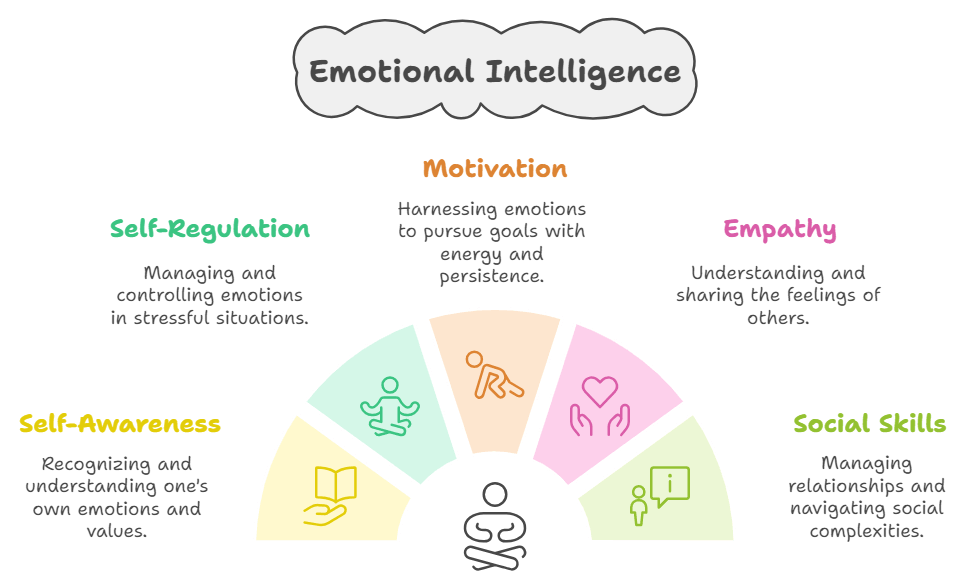
- Self-Awareness
- Definition: The ability to recognize and understand one’s own emotions, strengths, weaknesses, values, and drivers.
- Example: A manager who recognizes their frustration during a stressful meeting can take a moment to calm down before responding, preventing an emotional outburst.
- Application: Techniques like journaling or mindfulness meditation can help individuals become more attuned to their emotions.
- Self-Regulation
- Definition: The ability to manage and control one’s emotions, particularly in stressful situations, and to think before acting.
- Example: A teacher who feels anger towards a disruptive student but chooses to address the behavior calmly rather than yelling.
- Application: Practicing breathing exercises or cognitive restructuring to manage emotional responses effectively.
- Motivation
- Definition: The ability to harness emotions to pursue goals with energy and persistence.
- Example: An athlete who channels their excitement and anxiety before a big game into focused energy and performance.
- Application: Setting personal goals and visualizing success to stay motivated and driven.
- Empathy
- Definition: The ability to understand and share the feelings of others.
- Example: A nurse who senses a patient’s anxiety and responds with comfort and reassurance, improving the patient’s experience.
- Application: Active listening and practicing perspective-taking to enhance empathetic responses.
- Social Skills
- Definition: The ability to manage relationships, build networks, and navigate social complexities.
- Example: A salesperson who reads a client’s body language and adjusts their pitch to address the client’s unspoken concerns, leading to a successful sale.
- Application: Developing communication skills and practicing conflict resolution strategies to build and maintain strong relationships.
Application of Emotional Intelligence in Coaching
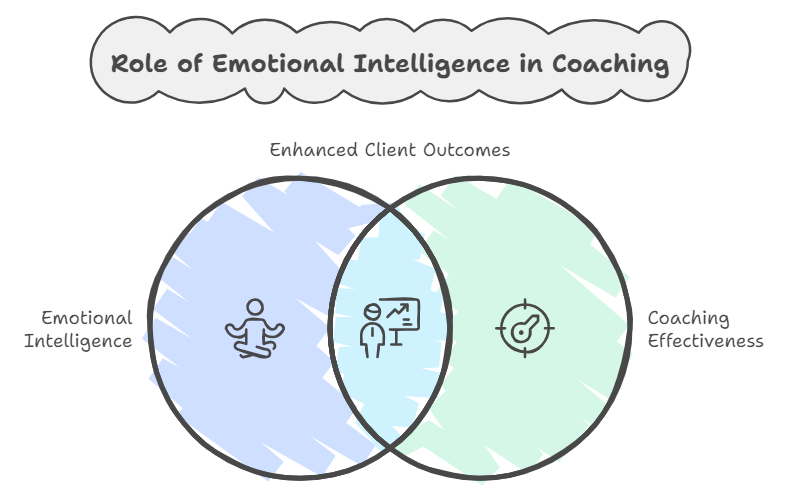
Emotional Intelligence in Coaching is essential for fostering a productive coach-client relationship. Coaches with high EI can better understand their clients’ emotional states, enabling them to provide more personalized and effective guidance. Here’s how EI plays out in coaching:
1. Building Rapport:
- Coaches use EI to create a trusting and empathetic environment, making clients feel understood and supported.
- Example: A coach senses a client’s hesitation and asks open-ended questions to encourage sharing, building a deeper connection.
2. Enhancing Communication:
- Effective communication is rooted in understanding emotions. Coaches with high EI can read non-verbal cues and respond appropriately, ensuring clear and constructive dialogue.
- Example: Noticing a client’s body language indicating discomfort, a coach might adjust their approach to make the client feel more at ease.
3. Facilitating Change:
- EI helps coaches to identify emotional barriers that might be hindering clients’ progress. By addressing these barriers, coaches can facilitate meaningful and lasting change.
- Example: A coach helps a client recognize how fear of failure is preventing them from taking action and works with them to build confidence.
4. Motivation and Goal Setting:
- Understanding what emotionally drives clients allows coaches to set motivating and achievable goals aligned with clients’ values and desires.
- Example: A coach uses a client’s passion for helping others to set career goals that are both motivating and fulfilling.
Application of Emotional Intelligence in Therapy
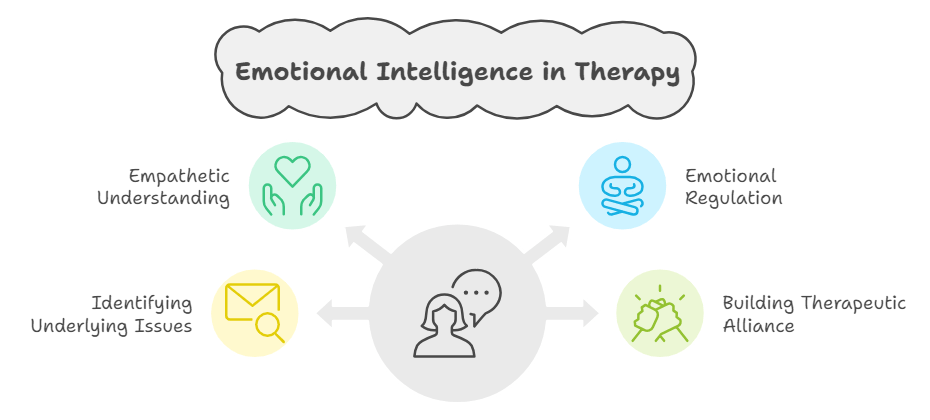
Emotional Intelligence in Therapy is a cornerstone of effective therapeutic practice. Therapists with high EI can navigate complex emotional landscapes, offering deeper and more nuanced support to clients. Here’s how EI enhances therapy:
1. Empathetic Understanding:
- Therapists use empathy to connect with clients, understanding their emotional experiences and providing validation and support.
- Example: A therapist listens attentively to a client’s story of loss, showing empathy and creating a safe space for the client to express their grief.
2. Emotional Regulation:
- Therapists with high EI can model and teach clients techniques for managing their emotions, leading to improved emotional regulation.
- Example: A therapist teaches a client with anger management issues how to use breathing techniques to calm down before reacting.
3. Identifying Underlying Issues:
- A strong grasp of EI allows therapists to identify and address the root causes of emotional distress, rather than just treating symptoms.
- Example: A therapist helps a client understand that their anxiety stems from a deep-seated fear of abandonment, which originated in childhood.
4. Building Therapeutic Alliance:
- A strong emotional connection between therapist and client fosters trust and safety, essential components of effective therapy.
- Example: A therapist consistently shows genuine concern and understanding, making the client feel valued and supported.
Cognitive Hypnotic Coaching and Psychotherapy and EI
At ICHARS we follow an eclectic approach to psychotherapy. An eclectic approach is based on seamless integration of different approaches to psychotherapy like cognitive, behavioural, humanistic, and psycho-dynamic with transformational techniques from Clinical Hypnosis, Neuro-Linguistic Programming, Mindfulness and Meditation, and Metaphors and Stories. An eclectic approach works on all components of a problem be it behaviours, thoughts, emotions, beliefs, values, defence mechanisms, secondary gain, traumas, and repressed memories.
SOFT SEA framework

The Cognitive Hypnotic Psychotherapy course at ICHARS is based on the SOFT SEA framework, a comprehensive system where each step is designed to help clients develop and enhance different components of emotional intelligence.
This framework encompasses numerous techniques that guide clients in becoming more mindful of their emotions, ultimately fostering greater self-awareness, self-regulation, motivation, empathy, and social skills.
This process encompasses delayering as a fundamental part. Each layer helps the client gain immense clarity.
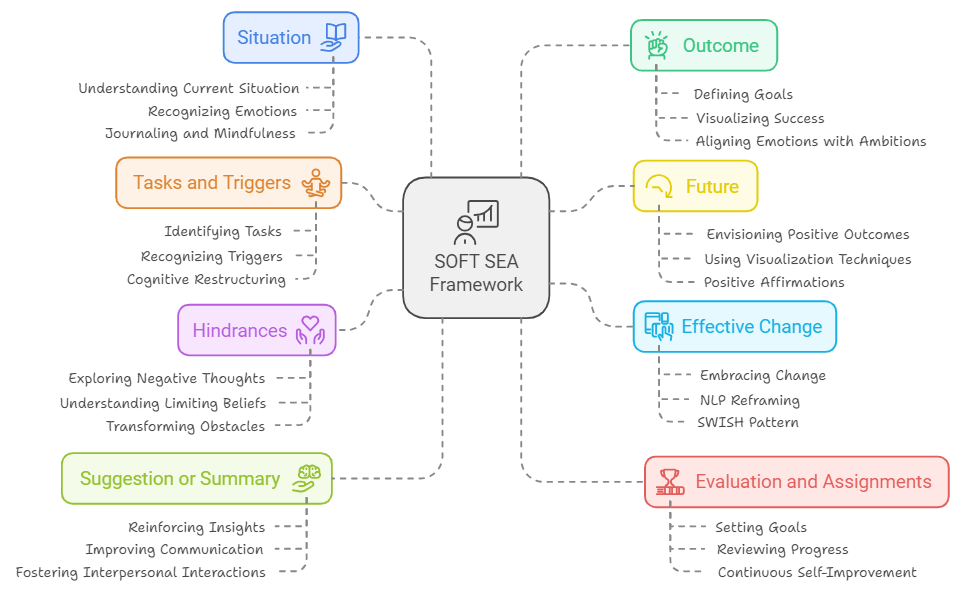
Steps of the SOFT SEA Framework
1. Situation
Component of EI: Self-Awareness
- Description: This step involves helping clients understand and articulate their current situation, including their feelings and perceptions.
- Development: By encouraging clients to recognize and verbalize their emotions and circumstances, this step enhances their self-awareness. Techniques such as journaling and mindfulness exercises can be employed to deepen their understanding of their emotional state and triggers.
2. Outcome
Component of EI: Motivation
- Description: In this step, clients define their desired future outcomes in concrete, sensory-specific terms.
- Development: By focusing on their goals and visualizing success, clients tap into their internal drive and motivation. This process helps clients align their emotions with their ambitions, fostering a sense of purpose and persistence in achieving their objectives.
3. Future
Component of EI: Positive Outlook
- Description: Clients are guided to envision their future with optimism, focusing on the positive changes they want to see.
- Development: This step helps clients cultivate a positive outlook by imagining successful outcomes and the emotions associated with them. Visualization techniques and positive affirmations can reinforce their belief in their ability to achieve these outcomes.
4. Tasks and Triggers
Component of EI: Self-Regulation
- Description: Clients identify specific tasks and potential triggers that may affect their progress towards their goals.
- Development: By recognizing and planning for these triggers, clients learn to manage their emotional responses proactively. Techniques like cognitive restructuring and breathing exercises are useful for enhancing emotional regulation.
5. Hindrances (Thoughts, Emotions, Beliefs, Values, Positive Intentions, and Past Experiences)
Component of EI: Empathy and Self-Awareness
- Description: This step involves exploring and understanding the internal hindrances that impede progress, such as negative thoughts, limiting beliefs, and past experiences.
- Development: By delving into these hindrances, clients become more empathetic towards themselves, understanding the roots of their emotions and behaviors. This self-awareness allows them to address and transform these obstacles into positive intentions.
6. Effective Change
Component of EI: Adaptability
- Description: Clients are guided through processes that facilitate effective change, helping them adapt new behaviors and thought patterns.
- Development: This step enhances adaptability by encouraging clients to embrace change and develop new strategies for dealing with emotional challenges. Techniques like NLP reframing and the SWISH pattern help clients rewire their responses to stimuli.
7. Suggestion or Summary
Component of EI: Social Skills
- Description: In this step, clients receive suggestions or a summary of their progress, reinforcing the therapeutic insights and actions.
- Development: This process helps improve social skills by enhancing communication and understanding between the client and therapist. It also solidifies the client’s ability to articulate their emotions and progress, fostering better interpersonal interactions.
8. Evaluation and Assignments
Component of EI: Achievement Orientation
- Description: Clients evaluate their progress and are given assignments to continue their development outside of sessions.
- Development: By setting and reviewing goals, clients cultivate an achievement-oriented mindset. This step encourages continuous self-improvement and accountability, driving them towards sustained emotional and personal growth.
The above delayering also helps the client become aware of their emotions and helps them access some of the unconscious elements like automatic thoughts, beliefs, and past experiences which are preventing the client from being able to put his or her best foot forward.
These unconscious elements thereafter, act as triggers leading to unwanted behaviour. There are different processes in the Cognitive Hypnotic Coaching and Psychotherapy framework that the coaches and the therapists can use to help clients become aware or become mindful of each of these elements or factors.
Developing Emotional Intelligence with Cognitive Hypnotic Coaching
Some of the techniques from the Cognitive Hypnotic Coaching and Psychotherapy module that the coaches and the therapists can in combination with the SOFT SEA framework to help their clients include
- When-then statement:A thought restructuring process that helps one replace negative thoughts with positive ones.
- SWISH Technique: Helps change troubling aspects of life by altering mental images associated with negative emotions.
- Core State process: Identifies and leverages the client’s core strengths.
- Dreams Interpretation: Provides insights into unconscious desires or fears.
- Levels of Transformation: Diagnoses and transforms various life areas, from environment to behaviours to skillsto beliefs to identities.
- NLP Reframing: Changes behaviors by understanding their positive intentions and applying alternate behaviors.
- Perceptual Positioning: Views situations from others’ perspectives to enhance empathy.
- Representation System: Helps clients understand how their mind processes information.
- Meta-model: Powerful Questions that elicits specific answers to explore current challenges deeply.
Enhancing Emotion Intelligence with Cognitive Hypnotic Psychotherapy
Addtional techniques that psychologists use in combination with SOFT SEA framework includes
- Emotional Empowerment Technique: Helps clients uncover deep emotional issues.
- Inner Child Healing: Connects with past experiences affecting current self-awareness.
- Ho’oponopono: Releases resentment, guilt, or negativity through forgiveness.
- Hypnodrama: Simulates interactions to understand interpersonal dynamics.
- Cord Cutting: Helps clients move on from unhealthy relationships.
These are just some of the techniques, there is a lot more that you will learn as a part of the program that will help you as a therapist develop mindfulness and that will help you help your clients become more mindful about important components of therapy.
Conclusion
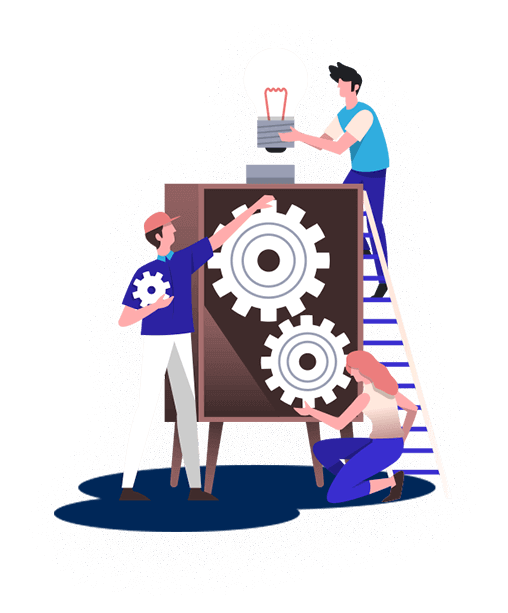
Emotional intelligence profoundly influences personal and professional life, enhancing self-awareness, relationships, and problem-solving skills. Integrating EI into coaching fosters strong connections, effective communication, and meaningful change, while in therapy, it allows for deep empathy, emotional regulation, and trust-building.
At ICHARS, our Cognitive Hypnotic Coaching and Psychotherapy programs leverage EI within an eclectic framework, combining various therapeutic techniques to address complex emotions and behaviors comprehensively.
The SOFTSEA framework and specialized techniques offer a robust foundation for enhancing professional practice and supporting clients more effectively.
For life coaches, trainers, and HR professionals, our Cognitive Hypnotic Coaching® Certification is an excellent opportunity to refine your skills. Psychologists, social workers, and medical practitioners can deepen their therapeutic practice through our Cognitive Hypnotic Psychotherapy® Program.
Explore these programs to harness the power of emotional intelligence, unlocking new levels of success and fulfillment for yourself and those you support. Join us on this transformative journey today.

